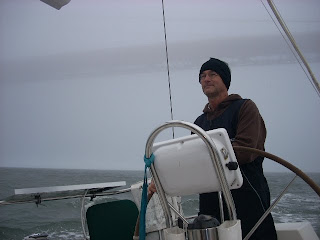 Leaving the Golden Gate bridge behind us in the fog.
Leaving the Golden Gate bridge behind us in the fog. 
Almost an unwritten law for prudent mariners is this: don't go into an unknown port in the dark. I've never been to Santa Cruz before, so it was falling into the domain of this law. Given this context, what were our options for getting here? At about 75 nautical miles away, conservatively estimating a 5 knot average, the math says it would take us 15 hours to get here from San Fran. So, leave at the crack of dawn (7am), hope to average faster and arrive here in no more than 12 hours? What if the wind died and we got here in the dark? We would have to heave to (stall, chill, back the sails so we don't go anywhere) and wait for dawn. Plus there is considering the ebb out of the Bay, or bucking the flood into it... Imagine getting out as early as possible only to have to stall once we get here. The better choice seemed to be to leave San Fran on the late afternoon ebb, sail all night, and arrive here when we would have come in anyway - thus getting most of a day to wander around SF.
So, that's what we did, and it's more than you wanted to know about how sailors think about this stuff. Anyway, we faced sailing all night as just the two of us (and with no moon), and left the Bay on the late afternoon big ebb...in fog. This was NOT thick fog, but we were glad for the radar's help, especially when it got dark. Once again, as per the forecast, we enjoyed wind and waves going our way, reached (it's a sailing term for sailing across or with the wind) all night, made some sail changes (mostly to slow down so we wouldn't get here before dawn) and gybed, stood one man watches, religiously wore our harnesses and clipped in, and got here in 17 hours. It really could not have gone much smoother.
Our weather luck continues. If "gentlemen never sail up wind," we've been near perfect gentlemen. Spent today, napping and then wandering around Santa Cruz. First impressions...i really like this place.
Would you like to know a little more about what offshore sailing is like? The fact that we are sailing 24/7 creates the environ we live in and the demands we have to meet. The biggest challenge (key to keeping the boat sailing well) is sleep. A tired crew makes bad decisions, fumbles at even simple tasks...is a step away from injury and other mistakes that could endanger the rest of the crew and the boat. That's why there is a clear "watch schedule." Whenever one can, off watch one should rest up for your next turn on watch.
The best places to sleep on a boat are aft (towards the back of the boat). The front of the boat is crashing thru waves, up and down,etc...so that is where we throw our duffel bags and stow stuff out of the way. The settees in the middle of the boat and in the aft cabin ride more comfortably. So we've put sheets on the cushions there, and arranged "lee cloths" on the inboard edge of the settees - these are any means that will keep someone from rolling out of bed when we tack. Cozy. We leave a sleeping bag on these settees, and each crewmember has their own identifiable pillow case on a pillow...
Imagine yourself in the middle of a dark night, on deck with your watch mate, keeping the boat going, sails trimmed, checkin' the radar, snacking or getting a hot cup of something, watching whatever you can make out on the horizon...waking me up if there's any question. You steer the boat for an hour (or let the autopilot do it) and then your watch mate drives for an hour while you lay on the cockpit bench and rest before your next hour at the helm. At the end of each hour (or at least each watch) you go below to the nav station and record the time, our course and speed and location and any event worth mentioning (a buoy or landmark or traffic passed?). You're wearing all your warm gear and foul weather clothing, along with a lifejacket and a chest harness that clips into a safety line anchored on each side deck. You and your watch mate cover four hours, listening for the ship's clock ring every half hour. You get to the end of those four hours, the next watch comes on deck, you go below and you take off your life jacket and harness (hand them to the next watch) you take off your boots, collapse into a sea-berth wearing most of your "gear" - that way, if the people on deck call for help, you can get back on deck quickly. During the day, when you go off watch you have one chore to do each day - maybe cook breakfast or dinner or chamois the decks or sweep the interior. And nap when you can. Your job is to nap.
It's a strange kind of romance, isn't it? Risking nausea, sleep deprivation and who knows what else. To be "out there." To face the ever changing unkown, perhaps no more than you do on shore, but to do so with intent, in a more dynamic environment... It would be very different if we dropped anchor or tied up somewhere every evening and you could count on a good night's sleep. Which is what i think will happen after we get into the Sea of Cortez. I'll read and write more... Shall see.
Luego,
jon
No comments:
Post a Comment